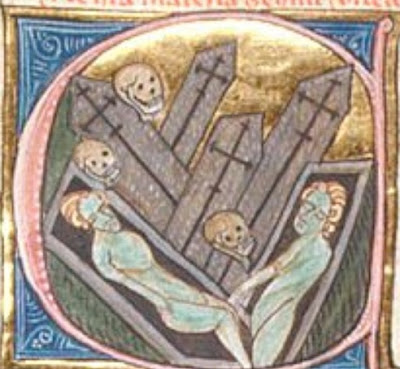Revise What You Teach about the Black Death
Professor Monica Green, a specialist in medieval European medicine at Arizona State University, argues that we should change the way we teach about the Black Death. (pdf copy here)
She lays out four new "truths' about the Black Death that she believes should be taught in middle and high schools.
New evidence shows that the "strains involved in the two areas would likely have had no direct relationship, other than both being the result of centrifugal spread out of a central Eurasian focus; pan-Eurasian transmission does not accord with any narrative accounts we have either of plague’s spread or of commercial activities in the period."
We also need to reexamine the way the plague spread. It did not spread by rats, but researchers are not really sure exactly how it did spread. Professor Green suggests that it is "unlikely that any single mechanism will explain everything."
What about the Mongols? Did they spread the plague? Professor Green believes more multidisciplinary research needs to be done to really understand the role of the Mongols. Their written sources do not mention the plague but that does not mean that it did not exist.
Professor Green cites threee advances in plague research as the basis for her argument. New genetics, for example, offers "a whole new mode of thinkng" about the disease."
Various types of new proxy evidence allows historians to reevaluate the severity of the plague's impact. Professor Green believes that we may have underestimated the extent of plague mortality and the extent of the geopgraphic spread of the disease.
Finally, medical research shows that the Black Death never ended. "Between 80 to 90% of plague strains identified in the modern world took their ori-gin after the great late medieval polytomy. Looked at another way, all those modern strains are evidence of how many locales proved continually hospitable to plague after the Black Death."
Professor Green links other Black Death resources within her essay. Her class syllabus, which you can find here, offers some resources and here is an extended reading list.
She lays out four new "truths' about the Black Death that she believes should be taught in middle and high schools.
- Genetics has given us a "unifed evolutionary history" of the plague.
- The Black Death was probably more devastating than previously imagined
- Sources are not always reliable
- The Black Death never ended.
New evidence shows that the "strains involved in the two areas would likely have had no direct relationship, other than both being the result of centrifugal spread out of a central Eurasian focus; pan-Eurasian transmission does not accord with any narrative accounts we have either of plague’s spread or of commercial activities in the period."
| Map reflecting views of William McNeil |
What about the Mongols? Did they spread the plague? Professor Green believes more multidisciplinary research needs to be done to really understand the role of the Mongols. Their written sources do not mention the plague but that does not mean that it did not exist.
Professor Green cites threee advances in plague research as the basis for her argument. New genetics, for example, offers "a whole new mode of thinkng" about the disease."
Various types of new proxy evidence allows historians to reevaluate the severity of the plague's impact. Professor Green believes that we may have underestimated the extent of plague mortality and the extent of the geopgraphic spread of the disease.
Finally, medical research shows that the Black Death never ended. "Between 80 to 90% of plague strains identified in the modern world took their ori-gin after the great late medieval polytomy. Looked at another way, all those modern strains are evidence of how many locales proved continually hospitable to plague after the Black Death."
Professor Green links other Black Death resources within her essay. Her class syllabus, which you can find here, offers some resources and here is an extended reading list.

Comments
Post a Comment